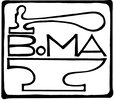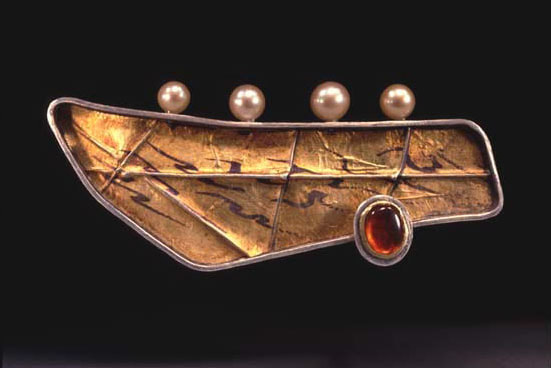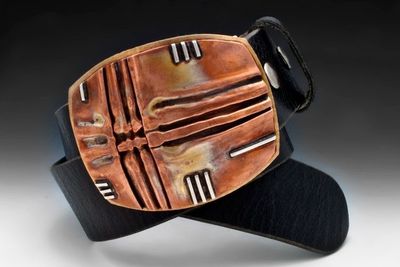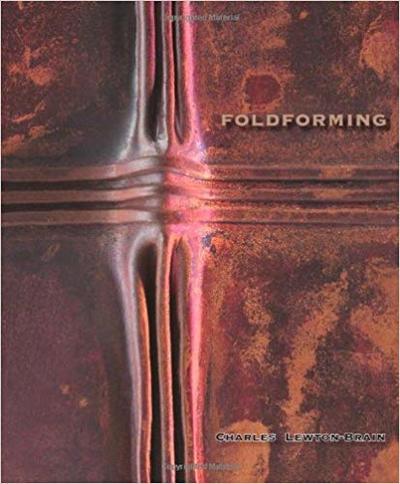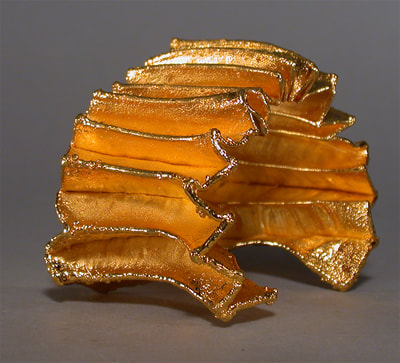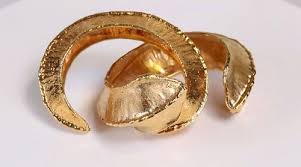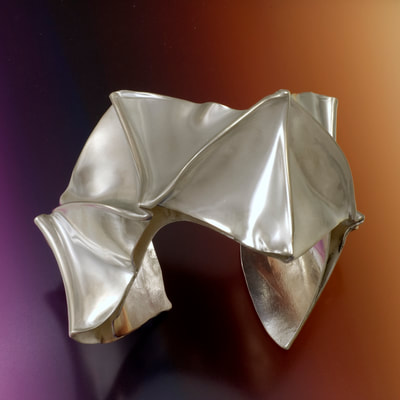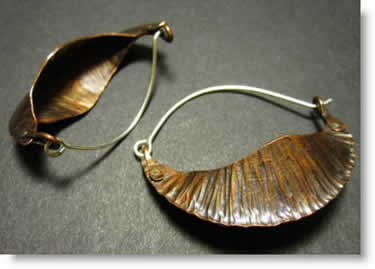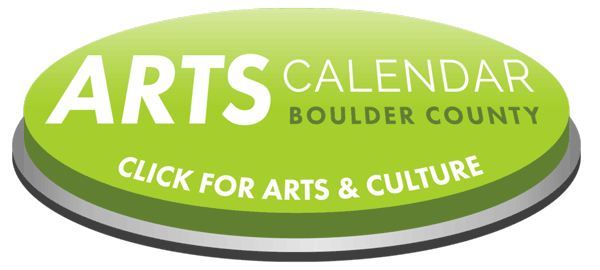Fold Forming for Jewelry: Working Small
with Charles Lewton Brain
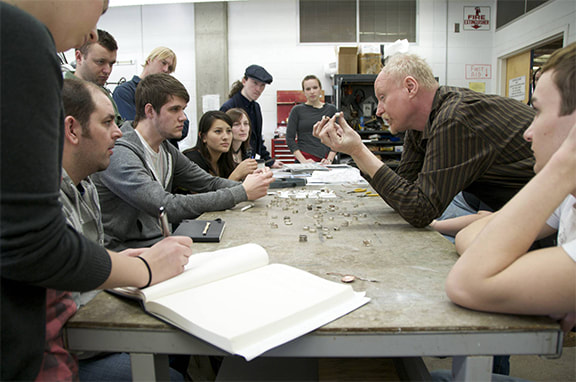
CLASS DECRIPTION
This workhop is about using foldforming methods in a smaller scale, aiming for jewelry making, concentrating on techniques that work for jewelry, and the most appropriate foldforming approaches for textures, shapes and designs for small work. Bracelets, brooches and earrings are addressed.
Fold forming is a rapid, easily learned way of shaping sheet metal with hand tools. Rather than forcing form upon the material, forms are derived from the natural plasticity, ductility and elasticity of the metal. It's an original invention and is internationally recognized as a new approach to working metal. Developed steadily since 1980, many schools teach it and thousands of people use the methods. Shaping is extremely efficient and fast (many radical changes in cross section and surface can be made in 3-5 minutes). Tools are simple; fingers, hands, hammers, mallets, anvils and rolling mills. Complex high relief forms are produced from single sheets of metal often with a single annealing. These shapes resemble chased, constructed and soldered forms. The techniques work with all metals and are applicable for jewellery, holloware, sculpture, enamelling, anodizing etc.
PREREQUISITES
students should have a basic knowledge of soldering and sawing
ABOUT THE INSTRUCTOR
Fold Forming was invented in the late 1980s by Charles Lewton-Brain, an English-born goldsmith who lived and studied in Tanzania, the United States, and Germany before moving to Canada. Outside of the Industrial Revolution, the method represents the first major innovation in metalworking in thousands of years.
Charles Lewton-Brain was able to develop his foldforming technique by seeing the characteristics of the metal as it is folded, unfolded, forged, rolled, annealed, and worked on. He brought about a new style of metalworking that had some connection to nature. His technique focused on the metal's natural reaction to being hammered and heated, based on his understanding of the metals elastic and ductile characteristics that were part of his instruction by Klaus Ullrich. Lewton-Brain continued to teach the foldforming technique to people at workshops and at Alberta College of Art and Design as the Head of Metals and Jewelry.
Charles also published two major books in 2008, Foldforming with Brynmorgen Press, and The Jeweler's Bench Book with MJSA Press. Since 2012 he has co-juried the Lewton-Brain Foldforming Competition, an international online exhibition.
Charles lived in Calgary since 1986 and served for 19 years as Head of the Jewellery/Metals Program at the Alberta College of Art and Design and teaches full time, writing articles, exhibiting, consulting and making work. In 1996 he began a web site collaboration with Dr. Hanuman Aspler in Thailand. The Ganoksin Project web site is now the largest educational site in the world for jewelers with over 4 million unique visitors a year who linger for an average of 20 pages and a 12,500 member archived, searchable discussion email list called Orchid. His writing started the site.
TOOLS AND EQUIPMENT STUDENTS SHOULD BRING
MATERIALS KIT* $55
.
MAXIMUM NUMBER OF STUDENTS: 10. Students will be required to sign a waiver. Participants must be 18 or older.
CANCELLATION POLICY
REGISTRATION OPEN NOW
This workhop is about using foldforming methods in a smaller scale, aiming for jewelry making, concentrating on techniques that work for jewelry, and the most appropriate foldforming approaches for textures, shapes and designs for small work. Bracelets, brooches and earrings are addressed.
Fold forming is a rapid, easily learned way of shaping sheet metal with hand tools. Rather than forcing form upon the material, forms are derived from the natural plasticity, ductility and elasticity of the metal. It's an original invention and is internationally recognized as a new approach to working metal. Developed steadily since 1980, many schools teach it and thousands of people use the methods. Shaping is extremely efficient and fast (many radical changes in cross section and surface can be made in 3-5 minutes). Tools are simple; fingers, hands, hammers, mallets, anvils and rolling mills. Complex high relief forms are produced from single sheets of metal often with a single annealing. These shapes resemble chased, constructed and soldered forms. The techniques work with all metals and are applicable for jewellery, holloware, sculpture, enamelling, anodizing etc.
PREREQUISITES
students should have a basic knowledge of soldering and sawing
ABOUT THE INSTRUCTOR
Fold Forming was invented in the late 1980s by Charles Lewton-Brain, an English-born goldsmith who lived and studied in Tanzania, the United States, and Germany before moving to Canada. Outside of the Industrial Revolution, the method represents the first major innovation in metalworking in thousands of years.
Charles Lewton-Brain was able to develop his foldforming technique by seeing the characteristics of the metal as it is folded, unfolded, forged, rolled, annealed, and worked on. He brought about a new style of metalworking that had some connection to nature. His technique focused on the metal's natural reaction to being hammered and heated, based on his understanding of the metals elastic and ductile characteristics that were part of his instruction by Klaus Ullrich. Lewton-Brain continued to teach the foldforming technique to people at workshops and at Alberta College of Art and Design as the Head of Metals and Jewelry.
Charles also published two major books in 2008, Foldforming with Brynmorgen Press, and The Jeweler's Bench Book with MJSA Press. Since 2012 he has co-juried the Lewton-Brain Foldforming Competition, an international online exhibition.
Charles lived in Calgary since 1986 and served for 19 years as Head of the Jewellery/Metals Program at the Alberta College of Art and Design and teaches full time, writing articles, exhibiting, consulting and making work. In 1996 he began a web site collaboration with Dr. Hanuman Aspler in Thailand. The Ganoksin Project web site is now the largest educational site in the world for jewelers with over 4 million unique visitors a year who linger for an average of 20 pages and a 12,500 member archived, searchable discussion email list called Orchid. His writing started the site.
TOOLS AND EQUIPMENT STUDENTS SHOULD BRING
- Notebook, pens, camera and film for recording samples.
- Safety goggles and ear plugs or muffs
- Hammers and mallets. Best are forging and raising hammers
- Cash or check made out to BoMA for materials kit*
MATERIALS KIT* $55
- Selection of emery papers
- 100 grit aluminum oxide paper
- 5 minute epoxy
- Thin copper sheet, 24 gauge (0.5mm). Precut
- Brass wire, 22 gauge, (0.8mm)
- 18g iron binding wire
- Amonia
- Table salt
- Hydrogen peroxide.
- Clear (transparent) auto enamel spray paint (or transparent lacquer)
- Solder (medium or hard wire solder)
- silicon carbide separating discs and screw mandrels for them
- 2 cardboard boxes
- Rubber cement
- Several Manila file covers
- Brown (or white) industrial-type paper towel
.
MAXIMUM NUMBER OF STUDENTS: 10. Students will be required to sign a waiver. Participants must be 18 or older.
CANCELLATION POLICY
- You may cancel up to 45 days prior to the start of the class and receive a full refund, less $25 processing. To cancel, send an email to [email protected].
- Cancellations less than 45 days prior to the start date will not be refunded,
- In the event we have to cancel a class, you will be notified prior to the start date and will be issued a full refund.
- Registration is not transferrable. You may not sell your seat to another student.
REGISTRATION OPEN NOW
For more examples of Fold Forming jewelry, visit Foldforming Hub and scroll to the bottom of the page.
